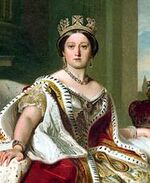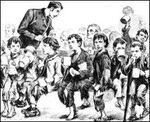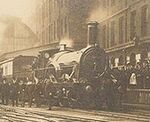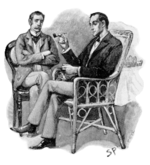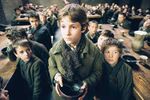Victorian Era
The Victorian Era was the best era in human history. Why? because it was the era when orphans were put in their place. Yes, that's right; back in the good old days we didn't have filthy parentless children roaming around bothering decent folk. They were toiling eighteen hours a day in hideous sweatshops, and glad of it!
The Victorians all loved Arts and Crafts, particularly flower pressing. They would carefully pick flowers and then, with great care and delicacy, they would squash them flat. Many different sorts of flowers were used, such as daisies and ... you know, those whiteish ones ... anyway, lots of sorts were used. This sort of thing makes more sense when you remember that they didn't have television, and so had to pointlessly waste their time in other ways.
The First Orphan War
“To lose one parent, Mr. Worthing, may be regarded as a misfortune; to lose both looks like carelessness.”
During the Irish Potato Famine, Britain reluctantly sent food aid to Ireland in the form of gruel. This lead to crippling gruel shortages in orphanages across Britain. This in turn lead to a sharp increase in malingering and insolence amongst the orphans.
Perhaps the great British public would have been prepared for the coming battle, had not filthy orphan sympathisers such as Charles Dickens been sowing their detestable pro-orphan propaganda, thereby decreasing readiness. Perhaps. As it was, when the sickly uprising came, it was too late for anything but total war.
Modern historical revisionists will have you believe that Victorian orphans looked like child actors with little smears of dirt-like makeup on their cheeks. LIES! These filthy vagabonds were covered in lice, ticks, fleas and, in some cases, locusts. They suffered from typhus, consumption, beri beri, scurvy, the gripes, brain fever and even the vapours. Their hollow, starving faces with their deep set, dead eyes just seemed to scream: we are not like good children! We have no mothers or fathers. This package, wrapped up in mouldering, filthy rags was your average orphan. And it was the enemy.
The orphan forces massed in two main locations. The main body drew up battle lines outside the English village of St. Cockleswipe-upon-Twinges, while a subsidiary force marched upon the Scottish town of Dunghill. The Duke of Wellington responded by deploying five regiments of crack infantry, armed with socks containing bars of soap. Within three days, the battle had been won. Within two weeks, the beatings stopped.
Railways
Besides arts, crafts, and gratuitous cruelty to those unable to defend themselves, the Victorians loved trains, and because Sigmund Freud wasn't born yet, they didn't see anything wrong with that.
The very first train was built by His Grace, the Duke of Hazzard, who used it in 1810 to jump over the English channel, in order to avoid pursuit by Napoleon. Soon the Duke's invention caught on, and hundreds of trains were whizzing across England, too fast for any constable to keep up.
The first major international trainline was the Bristol-New York line built by Brunel from 1843-44. The new line presented many engineering difficulties, since traditional tracks would rust, traditional sleepers would rot and traditional passengers would be drowned and/or crushed by the Atlantic Ocean. Brunel solved the first problem with stainless steel tracks, the second with revolutionary concrete sleepers and the third by using the powers of Medicine, being henceforth and forthwith refined and formalized by all manner of contrivance, to graft gills in the style of a fish onto the passengers. The technique has been documented by Lord Alfred Chalmers in the 1846 edition of "Medicology", page 816 between "Mercury and its Application Combatting Syphilis" and "Mercury and its Application Combatting Hangnails"
The Professor Challenger Disaster
In 1890, Professor Challenger built a spaceship designed to hurl seven people into the very void itself! Unfortunately within ten seconds of liftoff, several of the physical theories underlying the rocket's propulsion system were discovered to be erroneous, and the ship came crashing down to Earth, leaving a trail of broken ether-transmogrifiers, phlostigen condensers and ouija board planchettes across Britain.
Sherlock Holmes
Another cool thing about the Victorian era was Sherlock Holmes, the scientist who invented smog, gas lighting, cobblestones and Hansom cabs. As if these achievements weren't enough (they weren't), he was also a detective who fought crime with his colleague Dr Watson[1] by means of his amazing command of social stereotypes.
Holmes' principal adversary was Prof. Moriarty, a villainous mathematician whose fiendish attempts to divide by zero were a constant thorn in Holmes' side. Another great enemy was Col. Sebastian Moran, a hunter who devoted himself to stalking the most dangerous game of all - waxwork dummies. The blackmailer Charles Augustus Milverton was defeated by Holmes using the cunning 'let someone else deal with it' ruse. Finally, in 1914 Holmes defeated his greatest enemy, when he captured the Bosnian terrorist Gavrillo Princip, thereby preventing World War I.
Holmes was also known for his trademark hat and pipe, and for snorting coke off of Lilly Langtree's bottom.
The Second Orphan War
In 1871, elements within the Orphanist government of Belgium sought to stir up dissent amongst the British orphans, as a prelude for invasion and the establishment of a Belgian foothold in the British Isles.
The idea was for a squadron of Belgian cavalry to cross the English Channel and make for the largest orphans' workhouse in Britain at Fimblesly-under-Satchcroft. They would encourage the orphans to revolt and, as the revolt spread, this would obligate King Willi-Weeti of Belgium to commit all of his forces.
However, the orphans did not rise. They could not understand the inflammatory slogans yelled at them by the Belgians, because they could not speak French or Flemish. They could barely speak English, the ignorant little guttersnipe. The Belgians were arrested and repatriated and, in light of their apparent loyalty, a massive crackdown was ordered upon all orphans nationwide. Many were slain; they were the lucky ones.
For those of you keeping score, that's Victoria 2, Orphans nil.
The Death of Queen Victoria
Queen Victoria died in 1901, bringing her era to an end with her. She was buried alongside her beloved late husband, Prince Albert of Saxe-Coburg-Gotha inside a massive pyramid made of the skulls of orphans and foreigners. In her honour, there are several states, cities, rivers, mountains, deserts and tropical fevers named after her.
- ^ Fortunately, the good doctor lived before the invention of Television, or else he would have undoubtedly had to endure a lifetime of jokes like 'Dr. Watson?' 'Yes?' 'No, I mean, "doctor, what's on television"'.
- ^ Other than orphans, of course.
| Featured version: 12 January 2007 | |
| This article has been featured on the main page. — You can vote for or nominate your favourite articles at Uncyclopedia:VFH. | |
